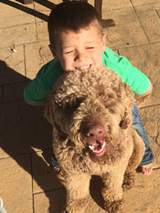Eli’s Story: A Dad Reflects on His Son’s CCAM Diagnosis
Eli’s Story: A Dad Reflects on His Son’s CCAM Diagnosis
When Eli was still in his mother’s womb, he was diagnosed with a congenital cystic adenomatoid malformation (CCAM), a large mass in his left lung. The condition can cause a host of life-threatening health problems. Here, Eli’s dad, Matt, shares the story of his family’s journey to hope and health at CHOP.
As told by Eli’s dad, Matt

My wife Amanda first found out something was wrong with our son Eli during an ultrasound 18 weeks into the pregnancy. The ultrasonographer’s face turned white and she said, “I’m going to go get the doctor.” When the doctor saw the ultrasound, his face turned white, too. All they could say was that Eli’s heart was on the wrong side of his chest.
Amanda called me crying. She was inconsolable. I rushed over to the doctor’s office and we went directly upstairs to see a high-risk obstetrician. They did another ultrasound and told us that Eli had a mass in his chest called a congenital cystic adenomatoid malformation (CCAM) lesion, which we had never heard of before. When the OB said most people would consider terminating, my fight or flight reactions kicked in. My hair was standing up on the back of my neck. I said that’s not an option for us, and we never want to discuss that again.
We left there feeling devastated, scared and confused. I started looking online at referral centers that took care of CCAMs. I’m an orthopedic surgeon, so I called a friend who is a pediatric surgeon and a friend who is a thoracic surgeon. Through all of that information-gathering, I was most impressed with The Children’s Hospital of Philadelphia (CHOP).
One week later, we flew from our home in Greenville, South Carolina, to CHOP’s Center for Fetal Diagnosis and Treatment for a daylong evaluation. We had an ultrasound, a fetal echocardiogram and a fetal MRI, and then met with the team to discuss the plan. They had to follow the size of the mass closely throughout the pregnancy because as the CCAM gets bigger, it can compress the heart to the point that it can’t fill up with blood. There was a chance that if it got to a certain size and interfered with heart function, Eli would require open fetal surgery.
The initial plan was for Amanda to fly to Philly every two weeks for monitoring at CHOP. She also had an ultrasound twice a week at a hospital near our home. If the pregnancy went well, Eli would be born at our local hospital and shortly after birth we would make the trip back up to CHOP for surgery to remove the tumor. But if at any point during the pregnancy the CCAM grew too big and was threatening Eli’s survival, the CHOP team had a plan B: delivery via an EXIT procedure or open fetal surgery at CHOP to remove the tumor before birth.
A possible complication
During that initial appointment, I told the doctors about my family history of what’s called malignant hypothermia, a genetic condition that can make anesthesia fatal. My older brother died during surgery because of this condition. I was tested and found out that I also have the condition, so Eli had a 50 percent chance of having it, too. It meant CHOP’s surgical team would have to use a special type of anesthesia during Eli’s surgery.
Luckily, we didn’t have to worry about surgery until after birth. As Eli grew, he outgrew the CCAM and his heart actually shifted back to where it was supposed to be. So he was able to be born in South Carolina through a collaboration that involved the CHOP team sharing information and expertise about how to deal with this condition with the doctors in our hometown.
Trusting in the team
When Eli was 10 weeks old, we drove up to Philadelphia for his surgery. Given what happened to my brother, the thought of handing Eli over to the team for surgery was really frightening. But the anesthesiologist was very attentive and spent a lot of time with us. The level of anesthesia care at a place like CHOP makes you more comfortable.
The surgery went well. Our MFM Dr. Khalek was in the OR observing and sent texts updating us on their progress. In removing the mass, the surgeons had to take out the lower half of Eli’s left lung, but his prognosis is excellent. The lung regenerates, so the rest of the lung will just fill in the gap. Eli was in the hospital for a few days and then we drove back home. We went back for his six-month follow-up, which coincided with the fetal reunion that year.

Eli is 5 years old now and is the absolute picture of health. At this point he has normal lung function. When he is 8 or 10, his CHOP doctors want him to have a pulmonary function test just to document that his lungs are OK, but he is active and strong.
We’ve started to tell Eli some of his story. He likes to show off his (very subtle) scar from surgery. He knows that Philadelphia is the place where the people who took care of him are.
We love Children’s Hospital and feel really connected to Philly, especially Dr. Khalek and Eli’s surgeon, Dr. Hedrick. We are really thankful for everyone at CHOP who took great care of Eli and of us, too.
Originally published June 2016